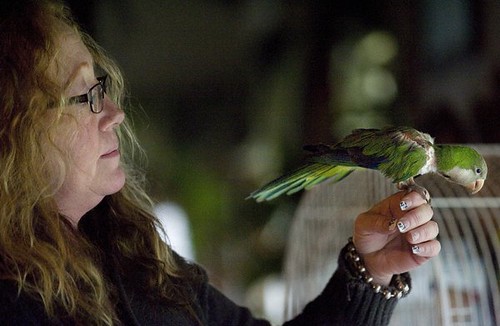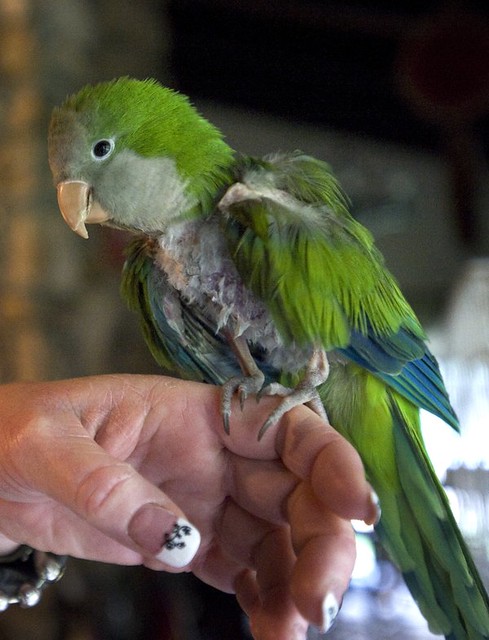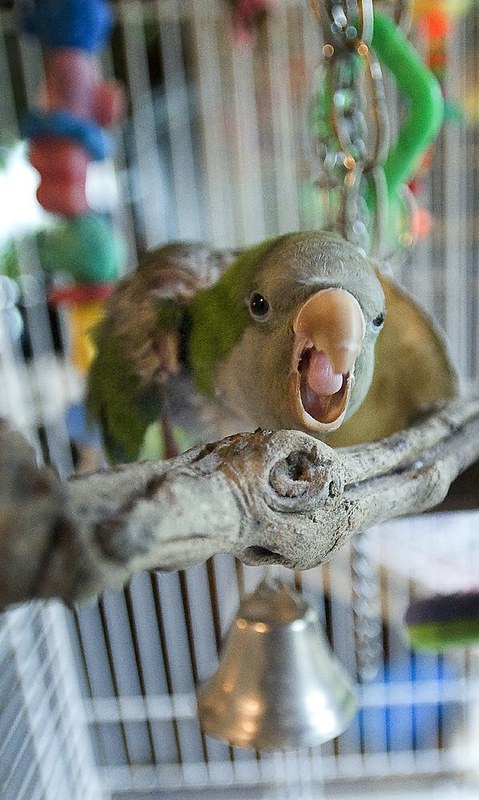Troubled parrot perseveres with help of loving owner
 Friday, March 2, 2012 at 13:27
Friday, March 2, 2012 at 13:27  Brenda Wilson inspects her parrot, Doc, inside her Battle Ground home. The parrot’s transformation over the past decade has been amazing to watch, Wilson’s friends and family said. Photo by Zachary Kaufman BATTLE GROUND “I’m a bad bird! I’m a bad bird! I’m a bad bird!”
Brenda Wilson inspects her parrot, Doc, inside her Battle Ground home. The parrot’s transformation over the past decade has been amazing to watch, Wilson’s friends and family said. Photo by Zachary Kaufman BATTLE GROUND “I’m a bad bird! I’m a bad bird! I’m a bad bird!”
Doc the parrot’s deep-voiced self-assessment bounced off the walls of Brenda Wilson’s home seconds after he bit his new owner on the finger. She had unknowingly committed the cardinal sin in his world. She had threatened his “baby bell.”
Wilson looked past Doc’s harsh indictment on that day a decade ago. Sure, he ripped out his feathers, attempted to slit his own throat with his beak and talked ceaselessly in the dark all remnants of a rough upbringing but he was not a bad bird, she reasoned. He needed love.
Ten years later, people who met Doc in those tumultuous early days marvel at his transformation from a turbulent, anxiety-ridden bird to a calmer one with excellent diction and counting skills, buoyed by years of watching “Sesame Street.” They marvel, too, at Wilson’s patience and compassion for an animal many others would have discarded.
 Doc the parrot perches on his owner Brenda Wilson’s hand. Ten years ago, the parrot was an anxiety-ridden threat to itself. Wilson is credited with bringing calm to the bird’s previously turbulent life. Photo by Zachary Kaufman The amazing thing, Wilson’s friends and family agree, is that what she has done for Doc she has done for hundreds of wayward animals, a quality that led one friend to liken her to St. Francis of Assisi, the patron saint of animals. She cared for them even as she raised her two children, now grown, and worked as a home health care nurse.
Doc the parrot perches on his owner Brenda Wilson’s hand. Ten years ago, the parrot was an anxiety-ridden threat to itself. Wilson is credited with bringing calm to the bird’s previously turbulent life. Photo by Zachary Kaufman The amazing thing, Wilson’s friends and family agree, is that what she has done for Doc she has done for hundreds of wayward animals, a quality that led one friend to liken her to St. Francis of Assisi, the patron saint of animals. She cared for them even as she raised her two children, now grown, and worked as a home health care nurse.
“I look back and think, ‘How in the heck did I do all that? How did I take care all of those critters?’” Wilson said this week, while sitting on her living room sofa.
A hard past
Doc arrived from Vancouver at Brenda Wilson’s door the same way most of the other 100 or so parrots she rescued in the 2000s did its owner could no longer care for it. Unlike most pets, parrots are a decades-long commitment and may outlive their owners.
Wilson’s ability to care for unwanted animals became so well-known in Clark County through word of mouth that parrot cages lined her living room and other previously open spaces in her home in Venersborg, a rural area outside Battle Ground. Even in a room full of castaways, Doc’s appearance raised alarms.
He reeked of smoke, his sticky feathers felt tarred and he plucked them incessantly. His feathers’ texture, in particular, made Wilson question whether he had been exposed through the air to illegal drugs. He was abnormally attached to a silver bell in his cage, which he often clutched in his beak.
Doctors at VCA East Mill Plain Animal Hospital treated Doc in 2002 for feather-plucking, a condition often caused by nutritional deficiencies or environmental causes. Blood work performed on him came back negative for any more serious maladies, said Dr. Alayson Phelps, a veterinarian and medical director at the animal hospital.
“(Birds) are busy and they’re very smart,” Phelps said. “If they’re kept in a state that’s not ideal, it causes them to start picking and self-mutilating.”
Doctors considered putting Doc, then 3 years old, on antidepressants, Wilson recalled.
The times he did not pick his feathers or bite his toenails, he hollered at the top of his lungs.
“You’d be having a conversation talking over this ‘arrrrrgh arrrrrrgh arrrrrgh,’” neighbor Jacqueline Freeman said. Freeman left Wilson’s house wondering how she put up with the bird’s screaming.
The thought of giving Doc away never crossed Wilson’s mind.
“Anything people are not able to take care of … she has a gift to take care of it and love it 100 percent,” her daughter, Jennifer, said.
Doc today
Wilson peeked into Doc’s white, 3-foot-high by 2-foot-wide cage Wednesday afternoon and implored him to talk.
Silence.
Doc is generally loquacious, Wilson said. He talks with her, as well as her three other parrots Colby, Angel and Panama who call her living room home. He also counts to 10 with Count Von Count while watching “Sesame Street” and laughs uproariously at “America’s Funniest Home Videos.”
Doc, now around 13 years old, showed no signs of clamoring for attention on this day.
 Doc the parrot prepares to protect his “baby bell.” Doc’s owner, Brenda Wilson, said she learned soon after rescuing Doc to respect his bell, which is his security blanket. Photo by Zachary KaufmanHe placed one foot in his mouth, a sign of nerves. He grasped “baby bell” but ignored Wilson’s requests to chirp “baby, baby, baby” into the bell, which is roughly the size of his tan beak. His neighbor to the right, Colby, soaked up the spotlight, announcing “I’m Colby” six or more times in succession.
Doc the parrot prepares to protect his “baby bell.” Doc’s owner, Brenda Wilson, said she learned soon after rescuing Doc to respect his bell, which is his security blanket. Photo by Zachary KaufmanHe placed one foot in his mouth, a sign of nerves. He grasped “baby bell” but ignored Wilson’s requests to chirp “baby, baby, baby” into the bell, which is roughly the size of his tan beak. His neighbor to the right, Colby, soaked up the spotlight, announcing “I’m Colby” six or more times in succession.
Wilson finally coaxed a reaction from Doc by saying “kitty, kitty, kitty,” in a rapid fire cadence that recalled baby talk.
“Kitty, kitty, kitty, kitty,” Doc recited, displaying his competitive habit of saying the term once more than she does.
Wilson’s communicative skills with the animals are uncanny, remarked Melinda Squires of Flying S Aviary in Battle Ground.
“She has a keen insight into what makes them tick,” Squires said. “You can see her mind working.”
‘Normal bird’
Through the years, Wilson passed her love of animals to her children and also the 22 children who participated in her day care program. That was the easy part.
The hard part?
Learning to let go of the animals and allow others to care for them, such as Bob Dawson’s Macaw and Amazon Sanctuary in the small town of Carnation, east of Seattle. She gave most of her birds to the sanctuary, after years of ill health after a vehicle accidentally rolled over her in a parking lot plus a bout with thyroid cancer.
Even as she recovers her health she instinctively puts her animals first.
Why?
“Comfort, I guess,” Wilson said. “I just enjoy being with them. I always have since I was a kid.”
She often brings vegetables to the sanctuary to feed her former parrots. The sanctuary is where her “babies are,” she noted.
Wilson quit her job as a home health care nurse a year ago. Now, she raises chickens and sells their eggs. She holds each chicken in her hands and talks to it. She shares this personal touch with all her animals: 300 chickens, four rabbits, four guinea pigs, three dogs, three ducks, three cats, two turtles and one chinchilla.
Not to mention arguably her greatest reclamation project, Doc.
“Isn’t that amazing that she can take a bird that’s screaming and freaked out and bring him back to being a normal bird?” Freeman asked rhetorically.
 Myiopsitta monachus - Monk Parakeet | in
Myiopsitta monachus - Monk Parakeet | in  At the Vet,
At the Vet,  Pet care,
Pet care,  Rescue,
Rescue,  Training
Training 
